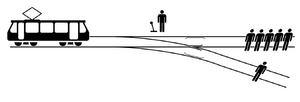Trolley problem facts for kids
The trolley problem is a famous thought experiment. It is an imaginary situation that helps people think about difficult choices. This problem explores how we decide what is right or wrong.
Most people believe the trolley problem was created by Oxford University professor Philippa Foot in the 1960s. Later, Massachusetts Institute of Technology professor Judith Jarvis Thomson made it very well-known. Many schools now use the trolley problem to teach about ethics. Jarvis Thomson was the one who gave it the name "the trolley problem."
The trolley problem does not have a single correct answer. Instead, it is a way to encourage people to discuss what makes actions good or bad. It helps us understand why we make certain choices.
Contents
How the Trolley Problem Works
Imagine you are near a trolley track. A fast-moving trolley is heading towards five people. These five people are stuck on the track and cannot move. The trolley will hit them and they will die.
You cannot stop the trolley. However, you can pull a switch. This switch would make the trolley change to a different track. On this second track, there is only one person. This person also cannot move out of the way.
If you do nothing, the trolley will kill five people. If you pull the switch, the trolley will kill one person. What would you do?
Different Versions of the Problem
There are many different versions of the trolley problem. These variations help us think about how small changes can affect our decisions.
The Emergency Room Case
Imagine you are a doctor in an emergency room. A person comes in who is not sick. Upstairs in the hospital, five other patients need organ transplants. The person who just came in is a perfect match for all five.
Like the trolley problem, you can act to save five people by harming one. Or you can do nothing and let five people die. This version was also part of Philippa Foot's original ideas.
Most people feel this situation is different from the trolley problem. The trolley problem is a very rare event. But doctors are taught to help people, not to harm them. Also, if doctors harmed patients for organs, people might stop trusting hospitals. This would make the problem much more complex to think about.
The Footbridge Case
Philosophers created the footbridge problem to be a simpler version of the emergency room case. It removes some of the complicated real-world issues.
In this version, you are standing on a small bridge over a trolley track. Again, a trolley is speeding towards five people who are stuck on the track. They cannot escape.
There is another person standing on the footbridge with you. This person is large enough to stop the trolley. If you push this one person off the bridge, their body will stop the trolley. This would save the five other people. But the person you push would die. You are not big enough to stop the trolley yourself.
Other Scenarios
Other versions of the trolley problem exist. For example, what if you know some of the people on the tracks? What if the one person on the second track is just taking a nap? These changes make us think even more about our choices.
What Happens in the Brain
Scientists have studied what happens in people's brains when they think about the trolley problem. A team led by Joshua Greene used an fMRI machine. This machine shows which parts of the brain are active.
When people thought about pulling the switch to save five people, the parts of their brain used for logical thinking lit up. This area is called the prefrontal cortex.
But when people thought about pushing someone off the footbridge, the parts of their brain linked to emotions lit up. This area is called the amygdala. People were less likely to choose to push the person.
Greene and his team believe that humans often use intuition and emotions for moral decisions. But they use logic when emotions are not as strong.
In Popular Culture
The trolley problem was featured in an episode of the TV show The Good Place. It was in the second season episode called "The Trolley Problem."
See also
 In Spanish: Dilema del tranvía para niños
In Spanish: Dilema del tranvía para niños


